If you are wondering why bugs and other pests pay your bathroom a visit, it’s because of all the moisture. And when we’re talking about the toilet seat, in particular, many people fail to clean it consistently and in detail. Flushing isn’t enough, since there is the residue left behind and that is enough to attract all the wrong guests.
Bright Side wants you to know that many pests can crawl into your house through your toilet and that there are ways to prevent this from happening.
1. Snakes
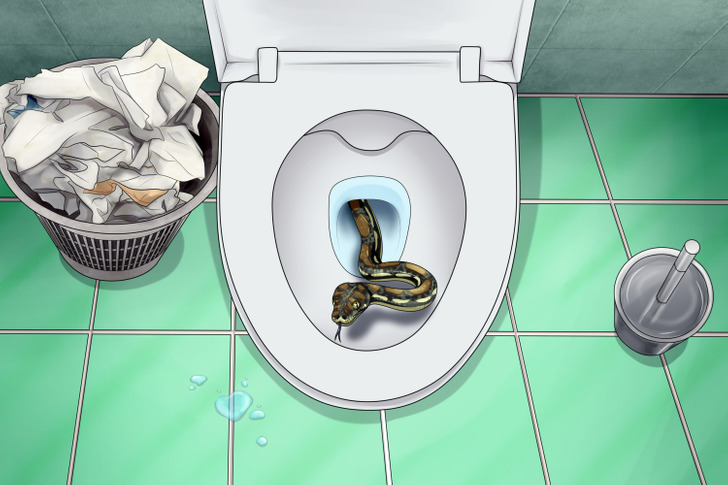
Snakes just love cool, wet, and dark places and that’s why your toilet pipes can be very intriguing to them. But, what drives them there in the first place is the sewer that has food remnants that they can feed on. When they are finished with their food in the sewer, they will look for a way out and the pipes are the easiest and quickest route. However, you shouldn’t be afraid if you live in a cold environment, since snakes will only sneak up in toilets in warm countries.
It’s usually harmless snakes that crawl through the pipes, like garden or tree snakes. That’s because these snakes are slimmer than venomous ones and can fit through the pipes. Although, some anacondas have appeared in people’s toilets in South America and Australia.
2. Rats
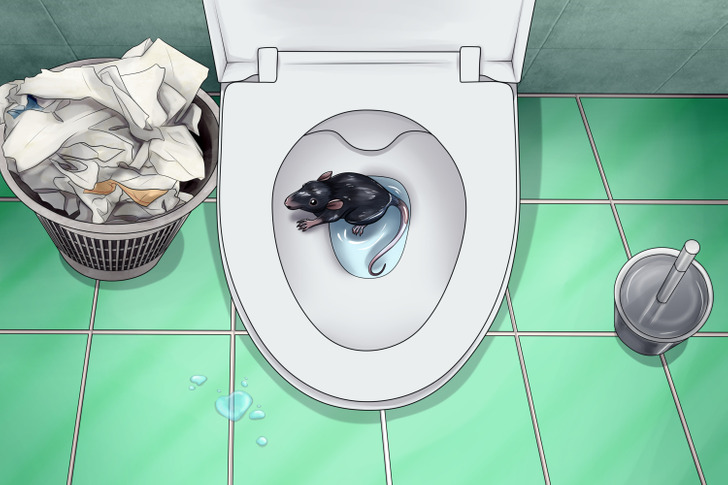
Like snakes, rats are also in constant pursuit of food and our pipes can be very appealing to them. In houses where the toilet and garbage disposal end up in the same pipes, rats are more likely to find a way in. And because their anatomy is very bendy, they can swim through the pipes and hold their breath for minutes before they need air.
So, it’s not just important to discard your food remnants in a trash bag but to also never flush food down the toilet. If there is no food in the pipes, rats won’t have any reason to try and enter your sewage system. You should also keep the toilet cover closed at all times and maybe install a rat guard. This allows water to exit the pipes whenever you flush, but nothing can come up in the opposite direction.
3. Spiders
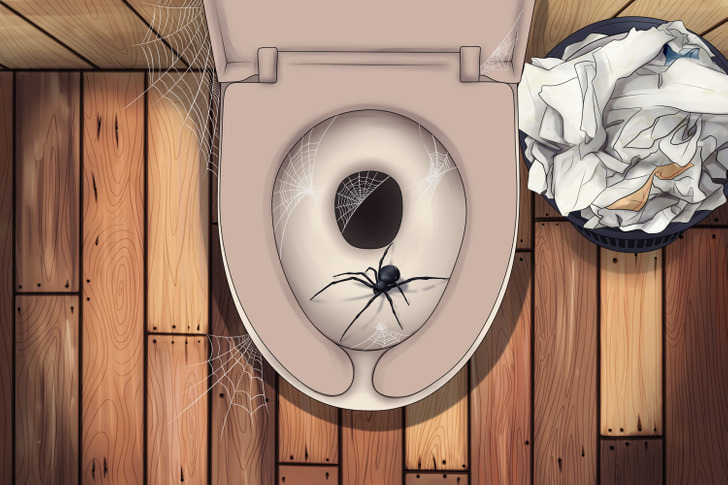
With spiders, things get a bit more complex, since they can’t swim in your pipes, but they can appear in your bathroom through another passage. And when they get in, they will probably sit outside the toilet seat. Only black widows will crawl inside the toilet and weave their web from side to side. But, that will happen only in an outdoor toilet that doesn’t have plumbing and that isn’t connected to a sewer system.
That’s where these venomous spiders thrive since there are many flies that they can catch for food. That’s also why you need to always check the seat thoroughly before using an outhouse toilet. Spiders, like the black widow, the brown recluse, and the hobo spider won’t have any trouble biting you.
4. Lizards
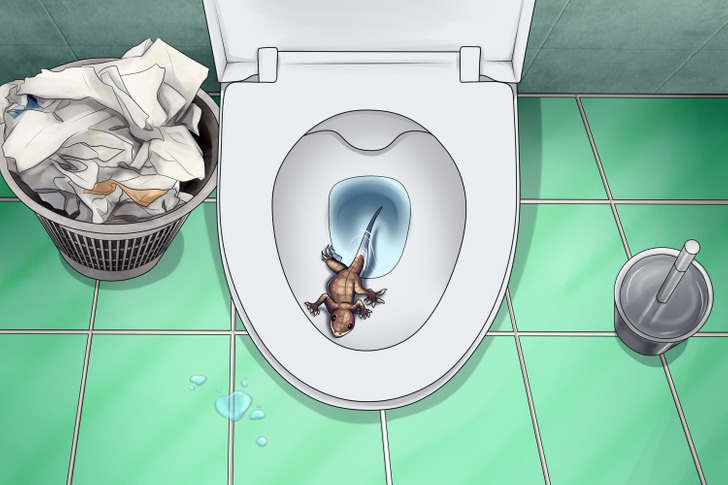
In the Southwest United States, lizards coming through the toilet pipes are a quite common occurrence. That’s because these creatures love water and they try to find food wherever they can. Crickets and other insects (like flies) can be found a lot in your toilet’s plumbing if it’s not kept decently clean. The lizards that can achieve this are usually small enough that they can fit through the pipes.
5. Possums
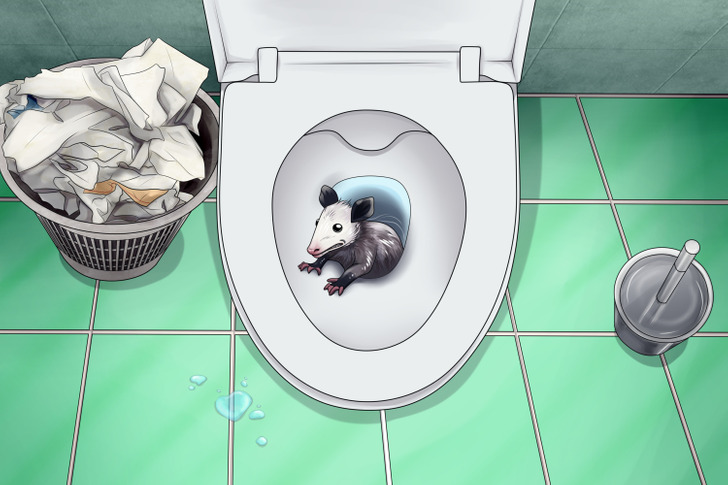
In 2008, a man was in his bathroom in Australia when he saw the water in the toilet gurgling. Moments later, a baby possum appeared and this is not the first time this has happened. On another occasion, a woman found a dead possum in her toilet. These unusual guests are excellent swimmers and can hold their breath for a long time — that’s why they can crawl into your toilet.
How to prevent and react to these occurrences
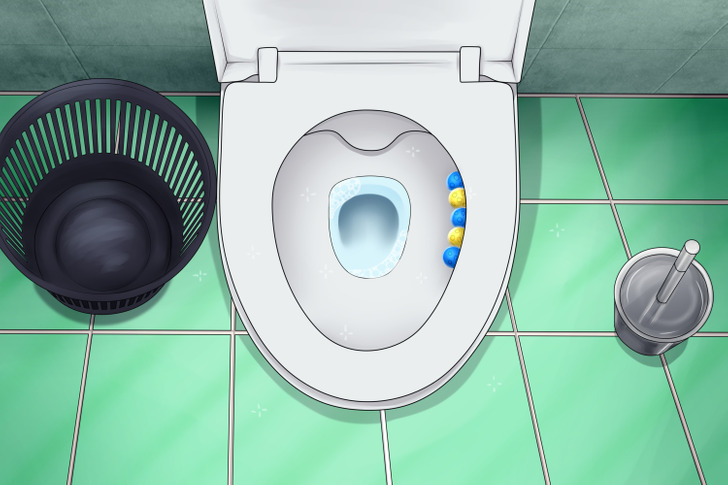
- Keep your toilet clean: This may sound obvious, but you really need to clean your toilet often and neatly. Disinfecting cleaners are perfect for that job and if you want something cheaper you can resort to white wine vinegar or baking soda. You can also get one of those fresheners that stick on the side of the toilet and release a nice smell every time you flush.
- Keep it dry: Most pests love humidity and that’s why they will be attracted to wet bathroom floors. So, it’s important to get rid of any standing water from the sink or the floor after you’ve taken a shower. If you notice any leaks in your plumbing, call a technician immediately and get them fixed.
- Clean your pipes naturally: In a bowl, add equal parts of sugar, water, vinegar, and 5-10 drops of dish soap. Mix all of this together and pour it down the toilet or in your bathroom sink. You can also pour some boiling water into the toilet.
- Call a pest control company: If you don’t have the time or courage to deal with pests yourself, call professionals and let them use their heavy cleaners. After that is done, you can occasionally throw water mixed with a cleaning solution down the drain to make sure no pest will climb up into the toilet.
Have you ever found an uninvited guest in your toilet — if so, what was it and how did you react?
Woman Spent Her Life Living for Others Until a Terrifying Diagnosis Changed Everything – Story of the Day

Sarah’s life has always revolved around her family, but a devastating call from the hospital forced her to confront everything she had put on hold. As she rediscovers herself and begins living on her terms, a surprising twist changes everything, leading her to see life completely differently.
That day started just like so many others before it. Sarah’s alarm rang at 5:40 A.M., pulling her from a restless sleep. She lay still, staring at the ceiling, before swinging her legs out of bed.

For illustration purposes only. | Source: Midjourney
She dressed quickly and shuffled downstairs, her slippers softly brushing against the hardwood floor.
In the kitchen, she scooped food into Bella’s bowl, the golden retriever wagging her tail eagerly.
“Morning, girl,” Sarah murmured, attaching Bella’s leash and stepping outside for a quick walk in the dim light.

For illustration purposes only. | Source: Midjourney
As they returned, Sarah thought of Mark and Ellie’s enthusiastic promises to care for Bella when they’d begged to adopt her. Those promises had faded quickly.
Back inside, Sarah methodically set the table for breakfast, placing bowls and plates in their usual spots.
She began ironing clothes, her mind already planning the rest of the day. After folding the laundry and quickly wiping the bathroom she hadn’t completed last night, she heard the alarms blaring upstairs.
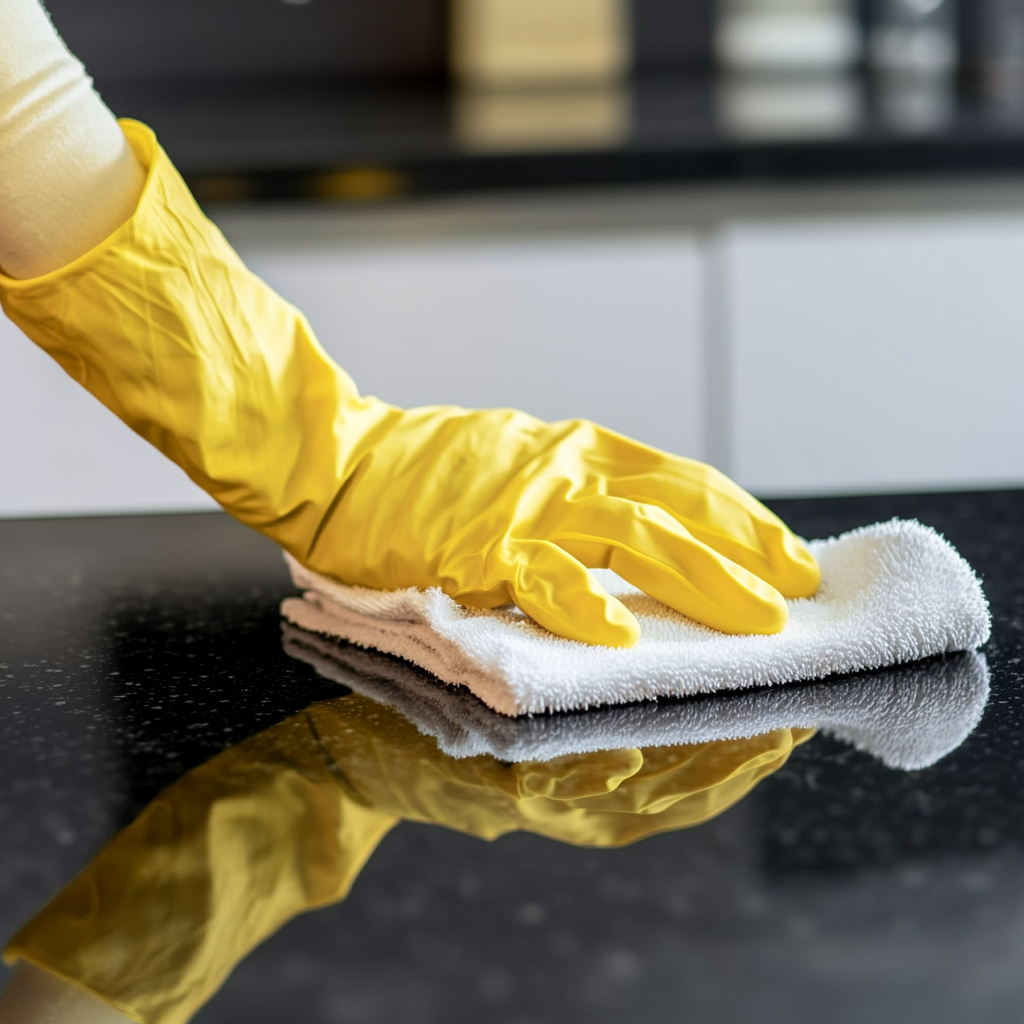
For illustration purposes only. | Source: Midjourney
Heading up, Sarah knocked on each door, calling gently, “Time to get up!” Ten minutes later, she repeated the process, her tone firmer.
She returned to the kitchen where she scrambled eggs and poured juice, setting the finished breakfast on the table as the family trickled in.
They ate quickly, Robert glancing at his phone, Mark and Ellie bickering over whose turn it was to sit closest to Bella.
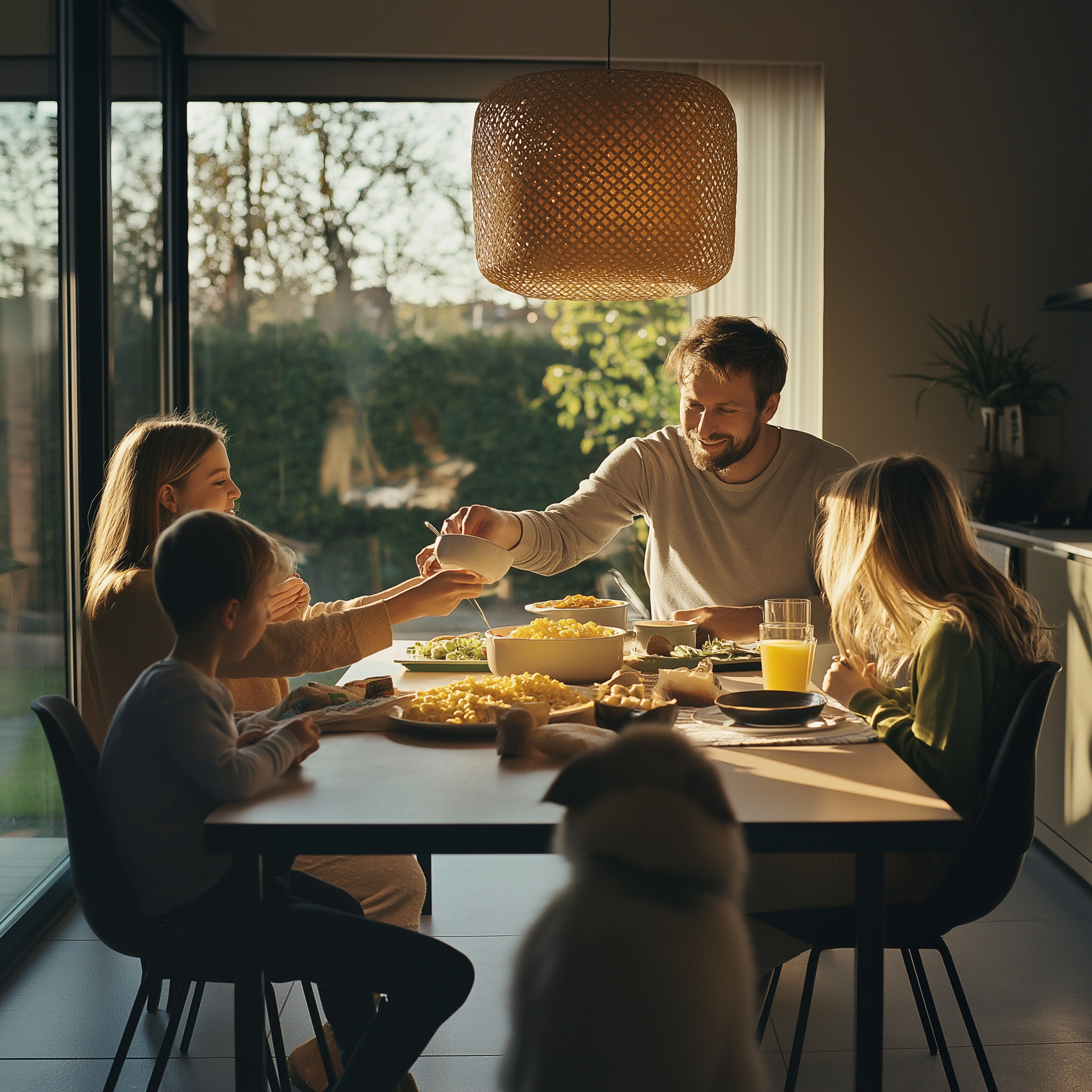
For illustration purposes only. | Source: Midjourney
Robert left first, giving Sarah a distracted peck on the cheek. She herded the kids into the car, enduring Ellie’s complaints about being late and Mark’s insistence he couldn’t find his cleats.
Finally, after dropping them off, Sarah leaned back in the driver’s seat and exhaled deeply. Her eyes drifted to the calendar on the dashboard.
A soccer game for Mark. Tutoring for Ellie. Another endless day stretched ahead, and already her body ached with exhaustion.

For illustration purposes only. | Source: Midjourney
Suddenly, Sarah’s phone buzzed, startling her as she sat in the car. She hesitated before answering, her heart pounding. “Hello?” she said, gripping the steering wheel tightly.
“This is Dr. Bennett from the hospital,” the voice on the other end began. Sarah’s stomach sank.
“We have your test results. I’m afraid it’s not good news. Your condition is serious, and unfortunately, treatment will no longer be effective.”

For illustration purposes only. | Source: Midjourney
Her breath hitched. “What… what does that mean?” she whispered, panic creeping into her voice.
“I’m sorry,” the doctor said gently. “You likely have less than a year. Perhaps only a few months.”
The phone slipped from her hand onto the passenger seat. Tears streamed down her face as the weight of the news crushed her.

For illustration purposes only. | Source: Midjourney
She thought: I’ve spent my whole life for them… but what about me?
When Sarah pulled into the driveway, she sat in the car for a while, staring at the garage.
Her thoughts raced as the weight of the morning’s news settled heavily on her chest.
Finally, she stepped out, opened the garage door, and was greeted by the smell of dust and forgotten memories.

For illustration purposes only. | Source: Midjourney
She dug through old boxes until she found them—her canvases, brushes, and paints.
Her hands trembled as she touched the faded materials, her mind flashing back to the dreams she once held so tightly.
Life had swept her away, one responsibility after another: marriage, kids, and an endless to-do list.

For illustration purposes only. | Source: Midjourney
Her dream of becoming an artist had been buried under it all. She sighed deeply and carried the supplies into the house.
Inside, chaos greeted her—dishes piled high, shoes scattered, and Bella’s leash abandoned on the floor.
Instinctively, Sarah began tidying, but as she passed the hallway mirror, her reflection stopped her in her tracks.

For illustration purposes only. | Source: Midjourney
Her tired eyes, wrinkled shirt, and unkempt hair reflected someone she no longer recognized.
Enough was enough. Sarah opened her phone, booked a salon appointment for the next day, and vowed: If I only have a few months left, I’ll live them for me.
That afternoon, she started clearing the garage. It would become her studio, her space to reclaim herself.

For illustration purposes only. | Source: Midjourney
When the kids returned home, Sarah sat on the couch, flipping through a book. She didn’t look up when Mark entered the room.
“Mom, why didn’t you come to my game?” Mark asked, frowning.
Ellie followed, crossing her arms. “And you were supposed to drive me to my tutor. I had to go by myself!”

For illustration purposes only. | Source: Midjourney
Sarah turned a page. “I took the day off. You’re both old enough to figure things out on your own.”
Mark’s stomach growled. “Well, what’s for dinner? I’m starving.”
“I don’t know. Make something and tell me when it’s ready,” Sarah said, her tone flat.
“Mom!” Mark and Ellie shouted together.

For illustration purposes only. | Source: Midjourney
“What now?” Sarah snapped, closing her book. “Every day, I cook, clean, and take care of you. Do you ever say thank you?”
The kids fell silent. Ellie glanced at Mark, then muttered, “Fine, I’ll make mac and cheese.”
“Good. Make enough for your dad too. He’ll be home soon.”
When Robert arrived, the kids bombarded him with complaints. He found Sarah in the living room.

For illustration purposes only. | Source: Midjourney
“Are you okay?” he asked quietly.
“I’m tired, Robert. I’m not your nanny or the kids’ servant,” she said.
He sighed. “Alright, I get it. Take a break,” he said, kissing her forehead.
The next morning, sunlight streamed through the curtains, but Sarah stayed in bed. She only stirred when Robert’s frustrated shouts broke the silence.

For illustration purposes only. | Source: Midjourney
“I’m going to be late!” he yelled, rushing around. Sarah heard him knocking on the kids’ doors, their groggy complaints echoing upstairs.
She stretched slowly, got up, and went downstairs. The kitchen was cluttered with dishes and crumbs from last night, but Sarah walked past it. She brewed coffee and sat quietly, sipping it.

For illustration purposes only. | Source: Midjourney
As the family came downstairs, their eyes widened at the empty table.
“Where’s breakfast?” Ellie demanded, scanning the counter.
“And lunch for school?” Mark added, looking confused.
Robert joined them, frowning. “Didn’t you make anything for work either?”

For illustration purposes only. | Source: Midjourney
Sarah sipped her coffee and set it down. “If you want breakfast, wake up earlier and make it yourself.”
“What’s that smell?” Mark asked, wrinkling his nose.
“Bella peed in the kitchen,” Sarah replied, her tone flat.
“Mom! Why didn’t you take her out?” Ellie cried.

For illustration purposes only. | Source: Midjourney
“You wanted a dog. You promised to care for her. That’s not my job,” Sarah said, leaning back in her chair.
“What’s wrong with you?” Ellie shouted. “We’re already late! Drive us to school!”
“You’re going with Dad today,” Sarah simply said.
Robert groaned, pulling out his car keys. “I’m already late for work.”

For illustration purposes only. | Source: Midjourney
“I have a salon appointment. I can’t take them,” Sarah said, standing.
Robert walked over, lowering his voice. “Sarah, this isn’t fair. I can’t manage everything alone.”
Sarah crossed her arms. “I’ve done everything for years. I can’t keep living like this. What if I died soon? You’d all figure it out.”

For illustration purposes only. | Source: Midjourney
“What are you talking about?” Robert asked, startled. “You’re fine.”
Sarah looked away, her voice soft. “I don’t feel fine anymore.”
Robert paused, then nodded. “I’ll talk to the kids. We’ll fix this.” He kissed her forehead and left with them.

For illustration purposes only. | Source: Midjourney
Later that night, Robert sat the kids down in the living room, his tone serious. “We need to talk about helping your mom,” he began. Ellie crossed her arms, and Mark slouched into the couch. “She’s done everything for us for years. Now it’s our turn to pitch in.”
Ellie frowned. “But I’m already so busy with school.”
Mark groaned. “This isn’t fair. Why can’t things just stay the same?”

For illustration purposes only. | Source: Midjourney
Tears and arguments followed, but the kids grudgingly agreed to try. The first week was chaos.
Dirty socks and papers littered the house. Bella’s leash often sat untouched, leading to more accidents.
Dinner consisted of burnt toast or hastily made sandwiches, and the kids squabbled constantly over chores. Robert, exhausted from work, struggled to wash dishes and keep order.

For illustration purposes only. | Source: Midjourney
Sarah, however, felt a weight lifted. She attended a painting class, where her passion reignited.
She smiled for the first time in years as she held a brush. After one of her frequent salon visits, she looked in the mirror and saw a confident and alive version of herself.
She started wearing her favorite clothes again, meeting friends for coffee, and hiking on weekends.

For illustration purposes only. | Source: Midjourney
Though she still helped here and there, Sarah left most of the responsibilities to the family. Over time, they adjusted, learning to share the load.
One evening, Robert surprised Sarah with dinner plans. She wore her favorite dress, and he picked the restaurant where they had their first date.
“I can’t remember the last time we went out like this, just the two of us,” Sarah said, her voice quiet but warm.

For illustration purposes only. | Source: Midjourney
“Me neither. It feels like a different lifetime,” Robert replied, reaching for her hand. “Listen, I’m sorry for putting so much on you. I didn’t realize how hard it was until you stopped doing everything. I promise you’ll never have to carry that burden again.”
Sarah smiled, but the smile quickly faded. Tears welled up in her eyes. She knew it was time to tell him about her diagnosis, about the months she might have left.

For illustration purposes only. | Source: Midjourney
“Robert, I—” she began, her voice breaking.
He interrupted with a grin. “Wait! I bought us tickets to Italy. Two weeks. We’ll leave in a month and a half. Mark and Ellie will stay with my parents. You’ve always wanted to go.”
Sarah nodded, grateful but heartbroken. “That’s… wonderful. But I need to tell you something.”

For illustration purposes only. | Source: Midjourney
Her phone buzzed, breaking the moment. “Sorry, I’ll just be a moment,” she said, stepping away.
It was the hospital again. The voice on the line was calm but apologetic. “We are so sorry. There was a mistake with your test results. Your diagnosis was incorrect. You’re perfectly healthy. The symptoms you experienced were due to stress and exhaustion.”

For illustration purposes only. | Source: Midjourney
Sarah froze, her hand gripping the phone tightly. Tears streamed down her cheeks, this time from overwhelming relief. “Are you sure?” she whispered, her voice shaking.
“Yes, absolutely. We deeply regret the error,” the caller said.
Sarah took a deep breath, wiping her eyes. “Thank you. Actually… you saved my life.”

For illustration purposes only. | Source: Midjourney
She hung up and walked back to Robert, her emotions raw. Without a word, she wrapped her arms around him.
“Sarah? What’s wrong? What did you need to tell me?” he asked concerned.
She pulled back just enough to look at him. Her voice was steady, filled with love. “Nothing. I just wanted to say I love you.” She kissed him, holding him close, her heart lighter than it had been in months.

For illustration purposes only. | Source: Midjourney
Tell us what you think about this story and share it with your friends. It might inspire them and brighten their day.
If you enjoyed this story, read this one: I dreamed of working in fashion, but on my first day, I faced whispers, judgment, and a boss who saw my size, not my talent. They didn’t believe I belonged—but I had a plan. When the runway lights came on, I knew it was my chance to prove them all wrong.
This piece is inspired by stories from the everyday lives of our readers and written by a professional writer. Any resemblance to actual names or locations is purely coincidental. All images are for illustration purposes only. Share your story with us; maybe it will change someone’s life.



Leave a Reply